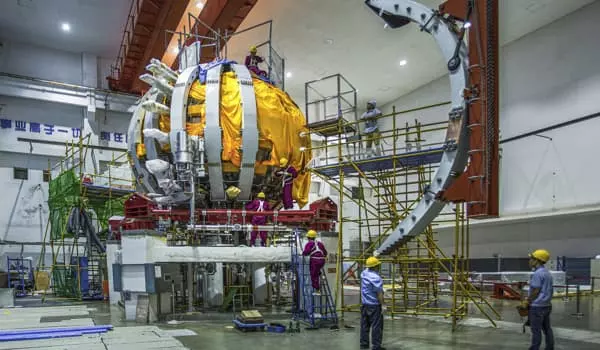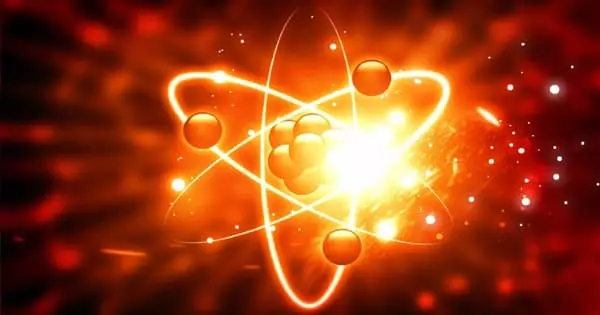The Sun and stars are powered by fusion, which occurs when hydrogen atoms fuse together to form helium and matter is converted into energy. When hydrogen is heated to extremely high temperatures, it transforms from a gas to a plasma in which negatively charged electrons are separated from positively charged atomic nuclei (ions). Fusion is normally not possible because the strongly repulsive electrostatic forces between the positively charged nuclei prevent them from getting close enough together to collide and fuse.
However, if the conditions are such that the nuclei can overcome the electrostatic forces and come within very close range of each other, the attractive nuclear force between the nuclei will outweigh the repulsive (electrostatic) force, allowing the nuclei to fuse together. Such conditions can arise when the temperature rises, causing the ions to move faster and eventually reach speeds fast enough to bring the ions together. The nuclei can then fuse, causing energy to be released.
A Chinese team of scientists claims to have discovered a low-cost method of achieving nuclear fusion that could compete with much more expensive alternatives. According to The South China Morning Post, researchers from the Chinese Academy of Sciences’ Institute of Physics began experimenting with fusion power at the Shenguang II laser facility last summer. However, the government only provided the team with $156 million over six years to conduct their experiments, a pittance in comparison to fusion reactors such as France’s International Thermal Experimental Reactor (ITER), which has an estimated budget of $45 to $65 billion.
The experiment involved directing 100 extremely powerful lasers at a single target, which eventually deformed the mirrors used to create the lasers and reduced their accuracy. Weaker laser beams were directed at two tiny gold cones, which emit hydrogen plasma at each other. A fusion reaction can occur when the exact right parameters are met.
Zhang Zhe
The researchers also wanted to improve on summer research at the National Ignition Facility (NIF), which resulted in more fusion energy output than had ever been produced in a lab before. The experiment involved directing 100 extremely powerful lasers at a single target, which eventually deformed the mirrors used to create the lasers and reduced their accuracy.
So, in addition to achieving fusion, the Chinese team had to figure out how to do it on a budget and with less powerful lasers. They eventually turned to a method developed in 1997 by Zhang Jie, a well-known Chinese physicist.
Weaker laser beams were directed at two tiny gold cones, which emit hydrogen plasma at each other. A fusion reaction can occur when the exact right parameters are met. While the gold cones vaporize after fusion, the overall cost will be “extremely small — if not negligible — in the future operation of a power plant,” according to Zhang Zhe, the experiment’s lead researcher. “A tiny grain of gold can produce thousands of cones.”

Despite some difficulties in their experiments, Zhang claims that the team was able to make significant progress. He hopes that in the future, the team will be able to scale their research with more sophisticated tools and facilities, which “will raise the game to a whole new level.”
When that happens, the team may have a fusion reactor that rivals the ITER’s capabilities — and at a fraction of the cost. It’s another exciting development in the race to develop fusion power, which could provide limitless clean energy and help provide a reliable alternative to fossil fuels. However, it is important to note that fusion energy will most likely not be unlocked by a single country, but rather through a collaborative effort by all.
“At this point, it is difficult to predict which approach or which country will win the race.” “There are far too many unknowns ahead,” said an anonymous nuclear fusion scientist to the SCMP. “However, in the end, different technologies and different nations may need to work together as one to bring fusion from dream to reality.”
The ultimate goal of EAST is to create nuclear fusion, similar to that of the Sun, by utilizing deuterium, which is abundant in the sea. Through a nuclear fusion reaction, deuterium from one litre of seawater can produce energy equivalent to 300 litres of gasoline.
To achieve nuclear fusion, enormous heat and pressure are applied to hydrogen atoms, causing them to fuse together. Nuclear fusion, as opposed to fission, is thought to be a safer process that produces no nuclear waste. Nuclear fusion has the potential to provide virtually limitless clean energy at very low cost.
China’s EAST project is a component of the International Thermonuclear Experimental Reactor (ITER) facility, which when completed in 2035 will be the world’s largest nuclear fusion reactor. This project involves several countries, including South Korea, Japan, Russia, India, and the United States. The EAST project’s next goal is to keep the temperature high for an extended period of time.















